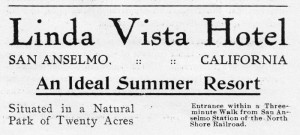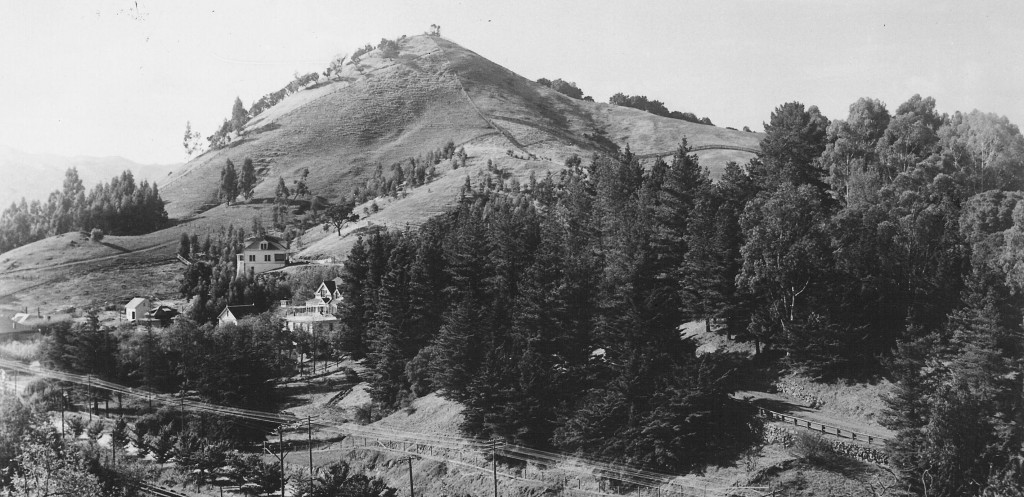
Red Hill from the East, Ancha Vista Hotel (lower left)
San Anselmo’s location along the route of the North Coast Pacific Railroad (later the Northwestern Pacific) and our temperate climate drew San Francisco residents to San Anselmo for a sunny break from summertime fog. Parents found the little town a safe place for their children, with no “objectionable places” for them to wander into. Businessmen found San Anselmo a suitable place to enjoy a vacation with their families while remaining in touch with business affairs. If necessary, a return to the office was easily accomplished by taking a quick trip on the train and ferry to San Francisco.
Hotel Accommodations
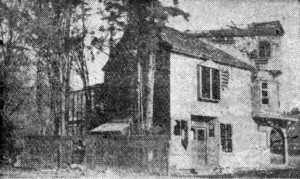
Rossi Hotel after 1910 fire
One hundred years ago vacationers had several San Anselmo hotels to choose from. Hotel Rossi, located where the Cheda Building now stands at Tunstead and San Anselmo Avenues, was overseen by proprietor James Rossi. San Anselmo Creek ran through the grounds. Conveniently located near the train station, the hotel accommodated 25 guests at rates from $7 to $15 a week. Sunday dinner was an advertised special, and the hotel also served fine candies and ice creams. The hotel was torn down after a major fire in December 1910.
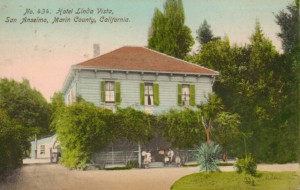
Hotel Linda Vista
The Linda Vista Hotel offered rooms for 90 guests in a natural park of 20 acres. It was located between Pine Street and Magnolia Avenue bordering along Cedar Avenue. There was a large dining room, dance floor, and tennis courts. Rates ranged from $10 to $15 per week. Linda Vista was originally built in the early 1870s as the home of James Ross Jr. and his wife Mary Miller. After Ross died and his widow married James Tunstead, the home was converted into a hotel with several different managers over the years. Tunstead sold the property in 1912, and the landmark building was torn down in 1918.
Villa Cazeaux was located in the 600 block of San Anselmo Avenue, between Magnolia Avenue and the Royal Sweet Bakery. The property ran down to the creek as San Anselmo Avenue hadn’t been cut through at this time. The hotel advertised 22 rooms, a dining room and stable on one acre. Open all year, it boasted telephone service and electric lights. Jean Cazeaux, a native of France, was the manager. He disposed of his interests in the hotel in 1915.
The largest hotel in San Anselmo was the Ancha Vista. Located on the eastern slope of Red Hill behind today’s Chapel of the Hills, the hotel had rooms and cottages for 150 guests, expansive grounds with plenty of shade and springs with “curative” properties. Rates were $2 to $3 per day. Dave Davis and his wife Fannie, natives of England, managed the hotel under a lease arrangement and later purchased it in 1911. In June 1915, the San Anselmo Herald reported that the Ancha Vista Hotel was doing a flourishing business; it was in close proximity to the municipal dance platform and jitney service was provided. The hotel was in operation until the early 1930s.
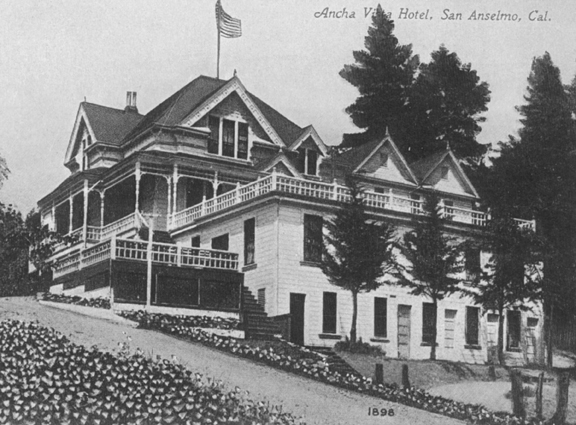
Ancha Vista Hotel
Campgrounds
Many families chose to camp along San Anselmo Creek. Lincoln Park, east of Sir Francis Drake Boulevard, featured a dance floor and ball field. Bernard Brennfleck offered campsites on his 8-acre nursery property along the creek in Yolanda Park. Water was piped to every camp. Peter Autzen’s Cottage Grocery, on the corner of San Anselmo Avenue and Redwood Road, catered to the summer vacationers by selling groceries and fresh produce, and having an open-air ice cream parlor. Visitors could register at the store so they could be located by friends.
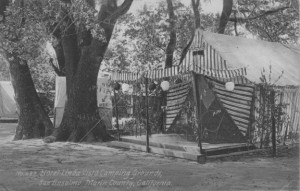
Hotel Linda Vista Campgrounds
The Linda Vista Hotel also offered tents and campsites. Early photographs of San Anselmo campsites show quite elaborate affairs with raised platforms, striped canvas tents, hammocks, and paper lanterns. Some were even outfitted with cast-iron wood burning stoves.
Further west, Salvatore Borello ran a summer resort on Butterfield Road which offered fine Italian food.
Summer Cottages
Shortly after the turn of the 20th century, large tracts of land in San Anselmo were subdivided, and city dwellers could now buy lots on which to erect summer homes or tent cabins. The Barber Tract, the slopes of Bald Hill, and the Yolanda and Lansdale areas were soon dotted with residences. A noted feature of the early homes and cottages was an outdoor sleeping porch large enough to accommodate the whole family. The Herald reported in January 1912 that practically all the bungalows and cottages for rent in the area had already been leased for the summer. A seven room bungalow with sleeping porch rented for $125 per month. In July 1912, summer visitors were so numerous in the Lansdale area that it looked like “the sidewalks of Market or Kearney.”
One Great Playground
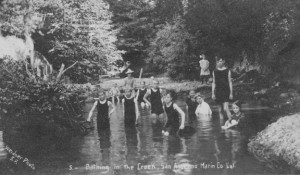
Lansdale Swimming Hole
Activities were numerous. There were the beautiful hills for hiking and picnicking. Youngsters enjoyed exploring the banks of San Anselmo Creek, and fish and crawdads were plentiful in its waters. In several places, the creek was dammed creating inviting swimming holes. Many adults would just curl up in a hammock with a good book. And certainly some of the visiting men took to the hills when deer season opened in late summer.
As one San Anselmo Herald writer put it “San Anselmo is one great playground adapted for young and old where it is impossible to think too much of business and where health and pleasure walk hand in hand.”


